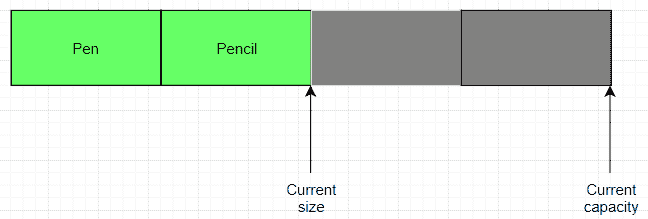# Java `ArrayList`示例
> 原文: [https://javatutorial.net/java-arraylist-example](https://javatutorial.net/java-arraylist-example)
Java `ArrayList`類是實現`List`接口的可調整大小的數組。 它允許所有元素(包括`null`),并且實現所有可選列表操作。 可以在`ArrayList`上運行的大多數操作,例如`size`,`isEmpty`,`get`,`set`,`iterator`和`listIterator`都是恒定時間。 但是,`add`操作的復雜度為`O(n)`時間。與[`LinkedList`](https://javatutorial.net/java-linkedlist-example)相比,常數因子低。

## `ArrayList`的優點
* 動態添加或刪除元素的能力。
* `ArrayList`使用數組作為其基礎實現,這使`ArrayList`類可以更快地訪問元素。
* 靈活性。
* `ArrayList`是面向對象的,因此您可以從中擴展并添加功能(如果需要)。
* 向`ArrayList`添加自定義行為是可能的,甚至很容易實現。
## `ArrayList`的局限性
* 添加元素需要`O(n)`時間。
* `ArrayList`將數據順序存儲在內存中,因此,如果列表很大,則將需要大量連續的內存塊。
* `ArrayList`的初始容量為 10,如果不指定容量,則將受到性能限制。 每當`ArrayList`達到其自身容量時,數據將以 50% 以上的容量從舊空間復制到新空間。
## `ArrayList`的簡單說明

Java 中的`ArrayList`
從上圖可以看到,`ArrayList`中當前有 2 個元素,可以添加的最大元素數量(容量)為 8(或 6 個以上)。
## `ArrayList`中的構造方法
1. `ArrayList()` – 構造一個初始容量為 10 的空列表。
2. `ArrayList(Collection <? extended E> c)` – 構造一個列表,該列表包含指定集合的??元素,并按集合的迭代器返回它們的順序。
3. `ArrayList(int initialCapacity)` – 構造一個具有指定初始容量的空列表。
## `ArrayList`類中的方法
1. `boolean add(E e)`:將指定的元素附加到列表的末尾。
2. `void add(int index, E element)`:將指定的元素插入列表中的指定位置。
3. `boolean addAll(Collection <? extends E> c)`:將指定集合中的所有元素附加到列表的末尾,以指定集合的`??Iterator`返回它們的順序。
4. `boolean addAll(int index, Collection <? extends E> c)`:從指定位置開始,將集合中的所有元素插入列表。
5. `void clear()`:從列表中刪除所有元素。
6. `boolean contains(Object o)`:如果列表包含指定的元素,則返回`true`;否則返回`false`。
7. `void ensureCapacity(int minCapacity)`:如果有必要確保列表可以容納最小容量參數指定的所有元素,則增加列表的容量。
8. `void forEach(Consumer<? super E> action)`:對已循環通過的每個元素執行給定的動作。
9. `int indexOf(Object o)`:如果列表不包含元素,則返回 -1。 但是,如果元素存在于列表中,則它返回此列表中指定元素首次出現的索引。
10. `boolean isEmpty()`:如果列表不包含任何元素,則返回`true`。
11. `Iterator<E> iterator()`:以適當的順序返回列表中元素的迭代器。
12. `int lastIndexOf(Object o)`:返回列表中指定元素最后一次出現的索引;如果列表中不存在該元素,則返回 -1。
13. `boolean remove(Object o)`:從列表中刪除第一次出現的指定對象。
14. `boolean removeAll(Collection<?> c)`:從列表中刪除指定集合中包含的所有元素。
15. `boolean removeIf(Predicate<? super E> filter)`:移除此集合中所有滿足給定謂詞的元素。
16. `void removeRange(int fromIndex, int toIndex)`:刪除列表中`fromIndex`和`toIndex`之間的所有元素。(`fromIndex`–包括在內,`toIndex`–排除在外)
17. `void replaceAll(UnaryOperator<E> operator)`:使用將運算符應用于該元素的結果替換列表中的每個元素。
18. `boolean retainAll(Collection<?> c)`:僅返回指定集合中包含的列表中的元素。
19. `int size()`:返回列表的大小。
20. `void sort(Comparator<? super E> c)`:根據`Comparator`指定的順序對列表進行排序。
21. `Object[] toArray()`:返回包含列表中包含的元素的數組。
有關所有方法的文檔,請訪問 [Oracle 官方文檔頁面](https://docs.oracle.com/javase/8/docs/api/java/util/ArrayList.html)。
### 使用`add()`在`ArrayList`中添加元素
```java
import java.util.* ;
public class ArrayListEgTwo
{
public static void main ( String[] args)
{
// Create an ArrayList that consists of Strings
ArrayList<String> animals = new ArrayList<String>();
// Capacity starts at 10, but size starts at 0
System.out.println("initial size: " + animals.size());
// Populating some of the arraylist
animals.add("Elephant");
animals.add("Tiger");
animals.add("Lion");
System.out.println("new size: " + animals.size());
}
```
**輸出**:
```java
size: 0
new size: 3
```
### 使用`remove()`移除`ArrayList`中的元素
```java
import java.util.* ;
public class RemoveExample
{
public static void main ( String[] args)
{
ArrayList<String> animals = new ArrayList<String>();
animals.add( "Elephant" );
animals.add( "Tiger" );
animals.add( "Lion" );
names.remove(1);
for ( int i=0; i < animals.size(); i++ )
System.out.println( i + ": " + animals.elementAt(j) );
}
}
```
**輸出**:
```java
0: Elephant
1: Lion
```
### 使用`isEmpty()`檢查`ArrayList`是否包含元素
```java
import java.util.* ;
public class isEmptyExample
{
public static void main ( String[] args)
{
ArrayList<String> animals = new ArrayList<String>();
System.out.println( "Case 0:" + animals.isEmpty());
animals.add("Tiger");
System.out.println( "Case 1:" + animals.isEmpty() );
nobby.clear();
System.out.println( "Case 2:" + animals.isEmpty() );
}
}
```
**輸出**:
```java
Case 0: true
Case 1: false
Case 2: true
```
### 使用`indexOf(Object o)`在`ArrayList`中搜索元素
```java
import java.util.* ;
public class IndexOfExample
{
public static void main (String[] args)
{
ArrayList<String> animals = new ArrayList<String>();
animals.add("Elephant");
animals.add("Tiger");
animals.add("Lion");
System.out.println("Index of 'Elephant': " + animals.indexOf("Elephant" ));
System.out.println("Index of 'Lion': " + animals.indexOf("Lion"));
}
}
```
**輸出**:
```java
Index of 'Elephant': 0
Index of 'Lion': 2
```
### 使用`Iterator()`遍歷`ArrayList`中的元素
```java
import java.util.* ;
public class IteratorExample
{
public static void main ( String[] args)
{
ArrayList<String> animals = new ArrayList<String>();
animals.add("Elephant");
animals.add("Tiger");
animals.add("Lion");
// Initializing an iterator
Iterator<String> iterator = animals.iterator();
// Using the iterator to visit each element
while(iterator.hasNext())
System.out.println(iterator.next());
}
}
```
**輸出**:
```java
Elephant
Tiger
Lion
```
### 使用增強的`For`循環遍歷`ArrayList`中的元素
```java
import java.util.* ;
public class ForLoopExample
{
public static void main ( String[] args)
{
ArrayList<String> animals = new ArrayList<String>();
animals.add("Elephant");
animals.add("Tiger");
animals.add("Lion");
for (String animal : animals)
System.out.println(animal);
}
}
```
**輸出**:
```java
Elephant
Tiger
Lion
```
### 使用`size()`獲取`ArrayList`的大小
```java
import java.util.* ;
public class ForLoopExample
{
public static void main ( String[] args)
{
ArrayList<String> animals = new ArrayList<String>();
animals.add("Elephant");
animals.add("Tiger");
animals.add("Lion");
System.out.println("Size of ArrayList: " + animals.size());
}
}
```
**輸出**:
```java
Size of ArrayList: 3
```
- JavaTutorialNetwork 中文系列教程
- Java 基礎
- Java 概述
- 在 Ubuntu 上安裝 Java 8 JDK
- Java Eclipse 教程
- Eclipse 快捷方式
- 簡單的 Java 示例
- Java 基本類型
- Java 循環
- Java 數組
- Java 讀取文件示例
- Java 對象和類教程
- 什么是面向對象編程(OOP)
- Java 封裝示例
- Java 接口示例
- Java 繼承示例
- Java 抽象示例
- Java 多態示例
- Java 中的方法重載與方法覆蓋
- Java 控制流語句
- Java 核心
- 如何在 Windows,Linux 和 Mac 上安裝 Maven
- 如何使用 Maven 配置文件
- 如何將自定義庫包含到 Maven 本地存儲庫中
- 如何使用 JUnit 進行單元測試
- 如何使用 Maven 運行 JUnit 測試
- 如何在 Java 中使用 Maven 創建子模塊
- 如何使用 Maven 創建 Java JAR 文件
- 如何使用 Maven 創建 Java WAR 文件
- JVM 解釋
- Java 內存模型解釋示例
- 捕獲 Java 堆轉儲的前 3 種方法
- Java 垃圾收集
- Java 互斥量示例
- Java 信號量示例
- Java 并行流示例
- Java 線程同步
- Java 線程池示例
- Java ThreadLocal示例
- Java 中的活鎖和死鎖
- Java Future示例
- Java equals()方法示例
- Java Lambda 表達式教程
- Java Optional示例
- Java 11 HTTP 客戶端示例
- Java 類加載器介紹
- Java 枚舉示例
- Java hashCode()方法示例
- 如何測試獨立的 Java 應用程序
- SWING JFrame基礎知識,如何創建JFrame
- Java SWING JFrame布局示例
- 在JFrame上顯示文本和圖形
- 與JFrame交互 – 按鈕,監聽器和文本區域
- 如何使用 Maven 創建 Java JAR 文件
- Java Collection新手指南
- 選擇合適的 Java 集合
- Java ArrayList示例
- Java LinkedList示例
- Java HashSet示例
- Java TreeSet示例
- Java LinkedHashSet示例
- Java EnumSet示例
- Java ConcurrentHashSet示例
- Java HashMap示例
- Java LinkedHashMap示例
- Java TreeMap示例
- Java EnumMap示例
- Java WeakHashMap示例
- Java IdentityHashMap示例
- Java SortedMap示例
- Java ConcurrentMap示例
- Java Hashtable示例
- Java 中ArrayList和LinkedList之間的區別
- Java HashMap迭代示例
- Java HashMap內聯初始化
- Java 中HashMap和TreeMap之間的區別
- Java 圖示例
- Java 深度優先搜索示例
- Java 廣度優先搜索示例
- 不同的算法時間復雜度
- Java 序列化示例
- Java 反射示例
- Java 中的弱引用
- Java 8 日期時間 API
- Java 基本正則表達式
- 使用 Java 檢索可用磁盤空間
- Java 生成 MD5 哈希和
- Java 增加內存
- Java 屬性文件示例
- 如何在 Eclipse 上安裝 Java 9 Beta
- Java 9 JShell 示例
- Java 9 不可變列表示例
- Java 9 不可變集示例
- Java 9 不可變映射示例
- Java 單例設計模式示例
- Java 代理設計模式示例
- Java 觀察者設計模式示例
- Java 工廠設計模式
- Java 構建器設計模式
- Java 比較器示例
- Java 發送電子郵件示例
- Java volatile示例
- Java Docker 和 Docker 容器簡介
- 安裝和配置 MySQL 數據庫和服務器以供 Spring 使用
- 如何在 Java 中使用 MySQL 連接器
- 如何使用 Eclipse 調試 Java
- Java EE
- 如何在 Windows 10 中設置JAVA_HOME
- JavaBeans 及其組件簡介
- 如何安裝和配置 Tomcat 8
- 如何在 Tomcat 中部署和取消部署應用程序
- 從 Eclipse 運行 Tomcat
- Java Servlet 示例
- Java Servlet POST 示例
- Servlet 請求信息示例
- Servlet 注解示例
- 使用初始化參數配置 Java Web 應用程序
- Java Servlet 文件上傳
- Java JSP 示例
- Glassfish 啟用安全管理
- 如何使用 MySQL 配置 Glassfish 4
- Java 文件上傳 REST 服務
- Glassfish 和 Jetty 的 Java WebSockets 教程
- 基于 Glassfish 表單的身份驗證示例
- 如何使用 Java EE 和 Angular 構建單頁應用程序
- Spring
- 在 Eclipse 中安裝 Spring STS
- 使用 STS 創建簡單的 Spring Web App
- Spring Web Framework 簡介
- Java Docker 和 Docker 容器簡介
- 在 Spring 中實現控制器
- Spring 中的PathVariable注解
- Spring 中的RequestBody注解
- Spring 中的RequestParam注解
- Spring 攔截器
- Spring IOC
- Java Spring IoC 容器示例
- Spring 中的DispatcherServlet
- Spring 示例中的依賴注入
- 實現 Spring MVC 控制器
- Spring ORM 簡介
- 什么是 DAO 以及如何使用它
- 如何對 DAO 組件進行單元測試
- 如何對控制器和服務執行單元測試
- 安裝和配置 MySQL 數據庫和服務器以供 Spring 使用
- 如何在 Spring 中處理登錄身份驗證
- Spring Security 簡介及其設置
- 如何使用 Spring 創建 RESTful Web 服務
- Spring CSRF 保護
- Spring 中基于 OAuth2 的身份驗證和授權
- Spring Boot 簡介
- Spring MVC 框架介紹
- Spring JDBC 簡介
- 如何 docker 化 Spring 應用程序
- Spring 的@Autowired注解
- Spring AOP 中的核心概念和建議類型
- Sping Bean 簡介
- 如何在 Java 中使用 MySQL 連接器
- 安卓
- 安裝和配置 Android Studio
- 將 Android 設備連接到 Android Studio
- Android 簡介,活動,意圖,服務,布局
- 創建一個簡單的 Android 應用
- 運行和調試 Android 應用程序
- 在虛擬設備上運行 Android 應用程序
- Android 活動示例
- Android 意圖示例
- Android 服務示例
- Android 線性布局示例
- Android 相對布局示例
- Android Web 視圖示例
- Android 列表視圖示例
- Android 網格視圖示例
- 帶有ListAdapter的 Android ListView示例
- Android SQLite 數據庫介紹
- Android SQLite 數據庫示例
- Android 動畫教程
- Android 中的通知
- Android 中的事件處理
- 如何在 Android 中發送帶有附件的電子郵件
- 雜項
- 選擇您的 JAVA IDE:Eclipse,NetBeans 和 IntelliJ IDEA
- Java S3 示例
- 如何在 Ubuntu 上為多個站點配置 Apache
- 如何在 Liferay DXP 中替代現成的(OOTB)模塊
- 簡單的 Git 教程
- 使用 Java 捕獲網絡數據包
- Selenium Java 教程
- 使用特定工作區運行 Eclipse
- 在 Eclipse 中安裝 SVN
- 如何運行 NodeJS 服務器
- SQL 內連接示例
- SQL 左連接示例
- SQL 右連接示例
- SQL 外連接示例
- 樹莓派
- Raspberry Pi 3 規格
- 將 Raspbian 安裝到 SD 卡
- Raspberry Pi 首次啟動
- 遠程連接到 Raspberry Pi
- 建立 Raspberry Pi 遠程桌面連接
- Raspberry Pi Java 教程
- 使用 PWM 的 Raspberry Pi LED 亮度調節
- Raspberry Pi 控制電機速度
- Raspberry Pi 用 Java 控制直流電機的速度和方向
